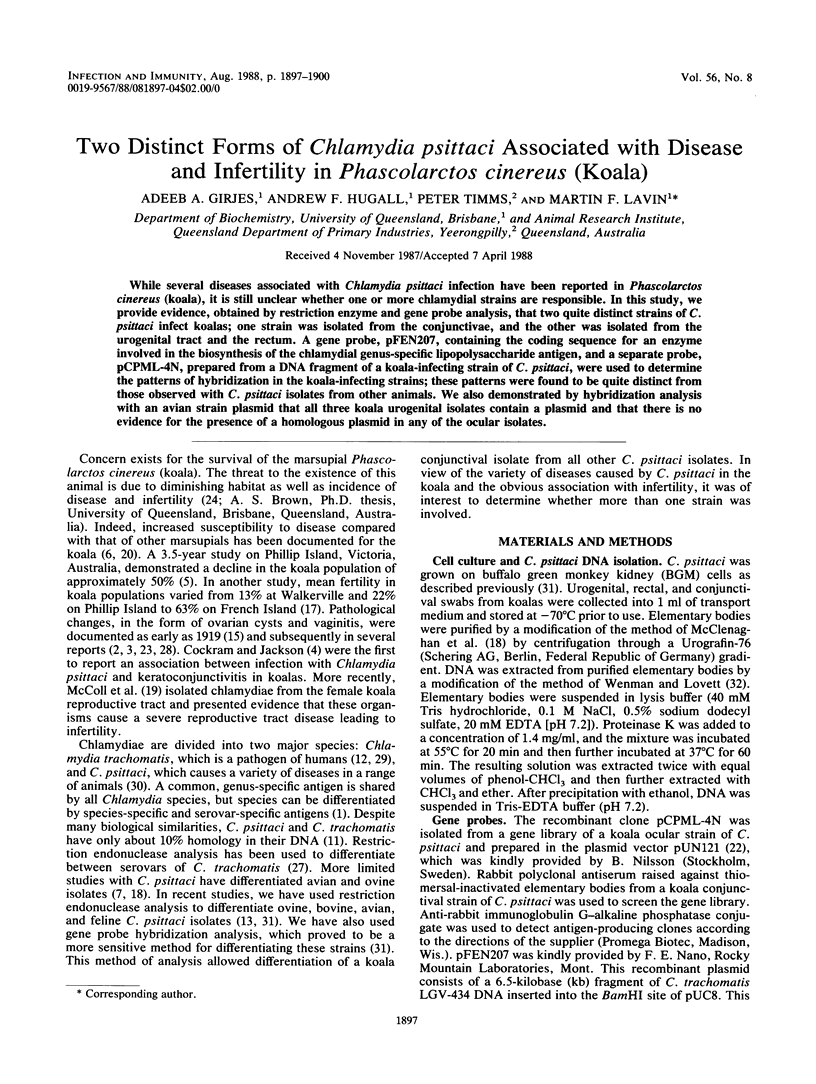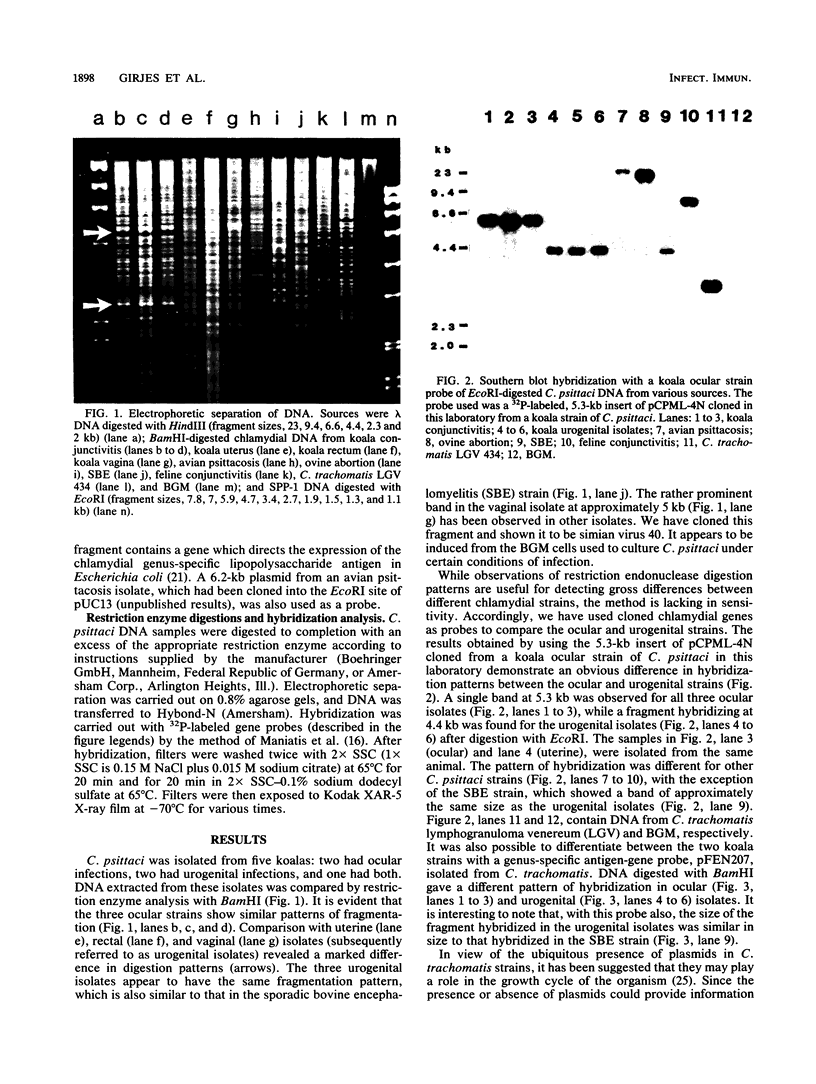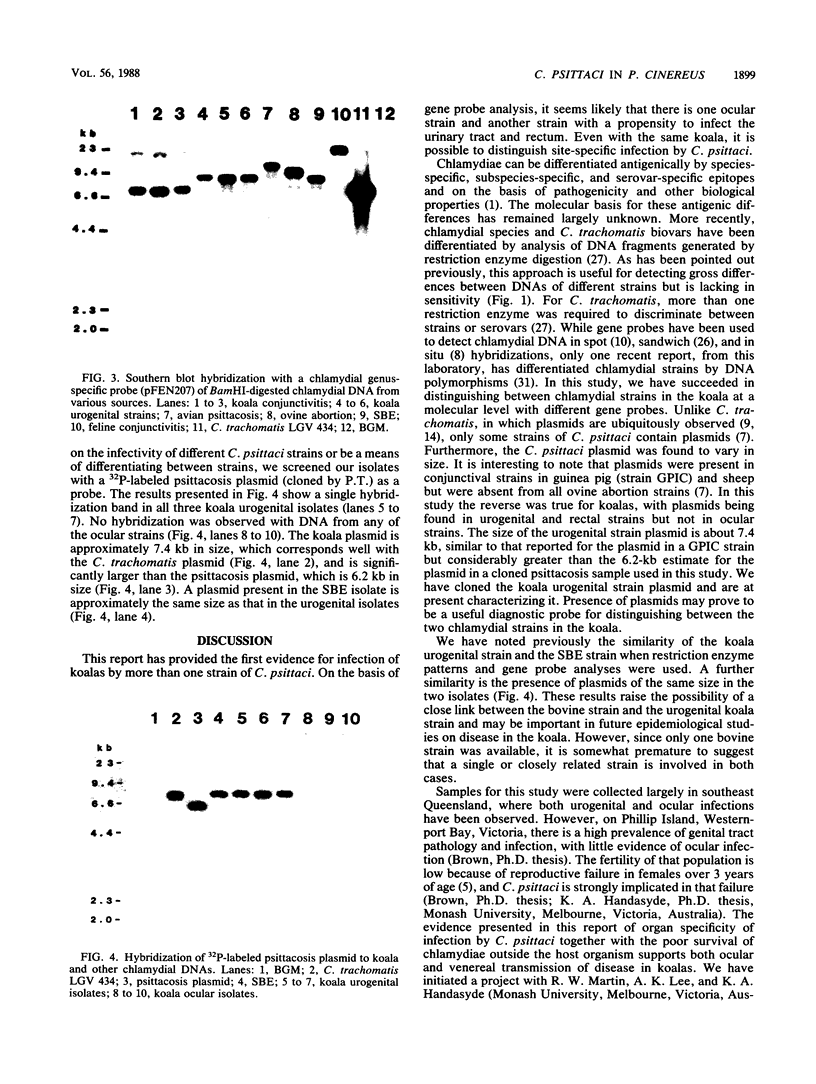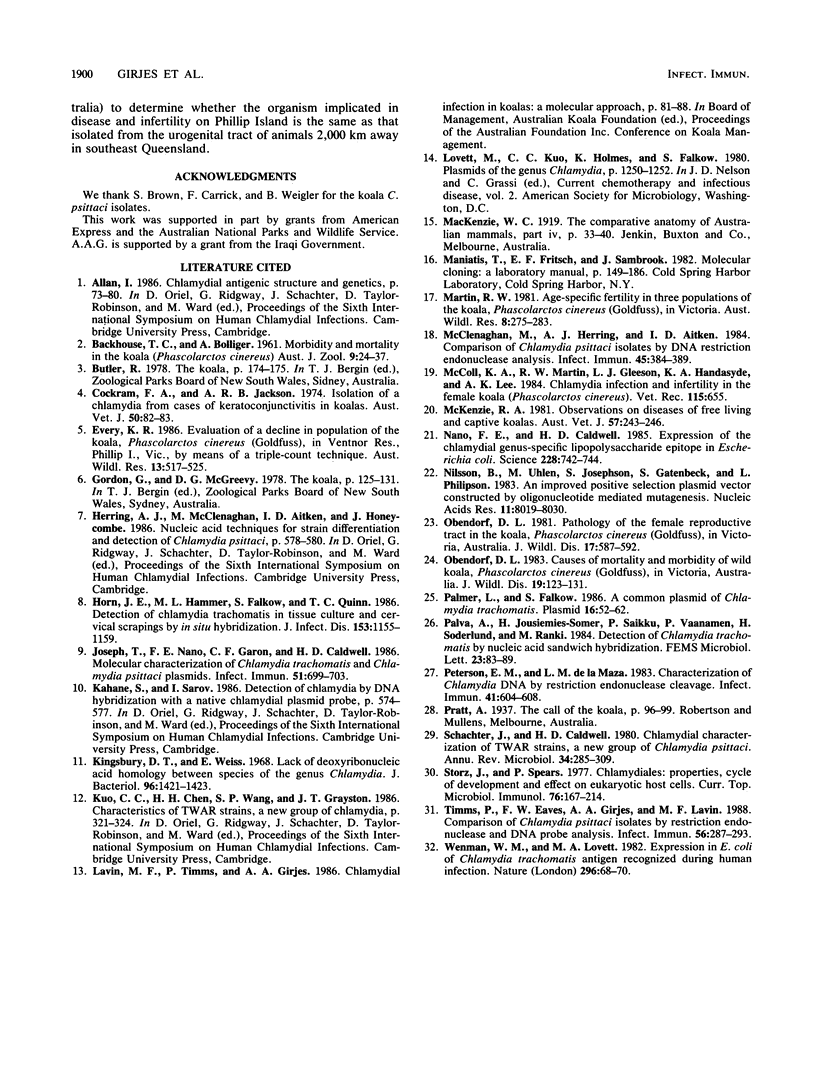Abstract
While several diseases associated with Chlamydia psittaci infection have been reported in Phascolarctos cinereus (koala), it is still unclear whether one or more chlamydial strains are responsible. In this study, we provide evidence, obtained by restriction enzyme and gene probe analysis, that two quite distinct strains of C. psittaci infect koalas; one strain was isolated from the conjunctivae, and the other was isolated from the urogenital tract and the rectum. A gene probe, pFEN207, containing the coding sequence for an enzyme involved in the biosynthesis of the chlamydial genus-specific lipopolysaccharide antigen, and a separate probe, pCPML-4N, prepared from a DNA fragment of a koala-infecting strain of C. psittaci, were used to determine the patterns of hybridization in the koala-infecting strains; these patterns were found to be quite distinct from those observed with C. psittaci isolates from other animals. We also demonstrated by hybridization analysis with an avian strain plasmid that all three koala urogenital isolates contain a plasmid and that there is no evidence for the presence of a homologous plasmid in any of the ocular isolates.
Full text
PDF



Images in this article
Selected References
These references are in PubMed. This may not be the complete list of references from this article.
- Cockram F. A., Jackson A. R. Letter: Isolation of a Chlamydia from cases of keratoconjunctivitis in koalas. Aust Vet J. 1974 Feb;50(2):82–83. doi: 10.1111/j.1751-0813.1974.tb05265.x. [DOI] [PubMed] [Google Scholar]
- Horn J. E., Hammer M. L., Falkow S., Quinn T. C. Detection of Chlamydia trachomatis in tissue culture and cervical scrapings by in situ DNA hybridization. J Infect Dis. 1986 Jun;153(6):1155–1159. doi: 10.1093/infdis/153.6.1155. [DOI] [PubMed] [Google Scholar]
- Joseph T., Nano F. E., Garon C. F., Caldwell H. D. Molecular characterization of Chlamydia trachomatis and Chlamydia psittaci plasmids. Infect Immun. 1986 Feb;51(2):699–703. doi: 10.1128/iai.51.2.699-703.1986. [DOI] [PMC free article] [PubMed] [Google Scholar]
- Kingsbury D. T., Weiss E. Lack of deoxyribonucleic acid homology between species of the genus Chlamydia. J Bacteriol. 1968 Oct;96(4):1421–1423. doi: 10.1128/jb.96.4.1421-1423.1968. [DOI] [PMC free article] [PubMed] [Google Scholar]
- McClenaghan M., Herring A. J., Aitken I. D. Comparison of Chlamydia psittaci isolates by DNA restriction endonuclease analysis. Infect Immun. 1984 Aug;45(2):384–389. doi: 10.1128/iai.45.2.384-389.1984. [DOI] [PMC free article] [PubMed] [Google Scholar]
- McColl K. A., Martin R. W., Gleeson L. J., Handasyde K. A., Lee A. K. Chlamydia infection and infertility in the female koala (Phascolarctos cinereus). Vet Rec. 1984 Dec 22;115(25-26):655–655. doi: 10.1136/vr.115.25-26.655. [DOI] [PubMed] [Google Scholar]
- McKenzie R. A. Observations on diseases of free-living and captive koalas. Aust Vet J. 1981 May;57(5):243–246. doi: 10.1111/j.1751-0813.1981.tb02670.x. [DOI] [PubMed] [Google Scholar]
- Nano F. E., Caldwell H. D. Expression of the chlamydial genus-specific lipopolysaccharide epitope in Escherichia coli. Science. 1985 May 10;228(4700):742–744. doi: 10.1126/science.2581315. [DOI] [PubMed] [Google Scholar]
- Nilsson B., Uhlén M., Josephson S., Gatenbeck S., Philipson L. An improved positive selection plasmid vector constructed by oligonucleotide mediated mutagenesis. Nucleic Acids Res. 1983 Nov 25;11(22):8019–8030. doi: 10.1093/nar/11.22.8019. [DOI] [PMC free article] [PubMed] [Google Scholar]
- Obendorf D. L. Causes of mortality and morbidity of wild koalas, Phascolarctos cinereus (Goldfuss), in Victoria, Australia. J Wildl Dis. 1983 Apr;19(2):123–131. doi: 10.7589/0090-3558-19.2.123. [DOI] [PubMed] [Google Scholar]
- Obendorf D. L. Pathology of the female reproductive tract in the koala, Phascolarctos cinereus (Goldfuss), from Victoria, Australia. J Wildl Dis. 1981 Oct;17(4):587–592. doi: 10.7589/0090-3558-17.4.587. [DOI] [PubMed] [Google Scholar]
- Palmer L., Falkow S. A common plasmid of Chlamydia trachomatis. Plasmid. 1986 Jul;16(1):52–62. doi: 10.1016/0147-619x(86)90079-x. [DOI] [PubMed] [Google Scholar]
- Peterson E. M., de la Maza L. M. Characterization of Chlamydia DNA by restriction endonuclease cleavage. Infect Immun. 1983 Aug;41(2):604–608. doi: 10.1128/iai.41.2.604-608.1983. [DOI] [PMC free article] [PubMed] [Google Scholar]
- Schachter J., Caldwell H. D. Chlamydiae. Annu Rev Microbiol. 1980;34:285–309. doi: 10.1146/annurev.mi.34.100180.001441. [DOI] [PubMed] [Google Scholar]
- Storz J., Spears P. Chlamydiales: properties, cycle of development and effect on eukaryotic host cells. Curr Top Microbiol Immunol. 1977;76:167–214. doi: 10.1007/978-3-642-66653-7_5. [DOI] [PubMed] [Google Scholar]
- Timms P., Eaves F. W., Girjes A. A., Lavin M. F. Comparison of Chlamydia psittaci isolates by restriction endonuclease and DNA probe analyses. Infect Immun. 1988 Jan;56(1):287–290. doi: 10.1128/iai.56.1.287-290.1988. [DOI] [PMC free article] [PubMed] [Google Scholar]
- Wenman W. M., Lovett M. A. Expression in E. coli of Chlamydia trachomatis antigen recognized during human infection. Nature. 1982 Mar 4;296(5852):68–70. doi: 10.1038/296068a0. [DOI] [PubMed] [Google Scholar]






